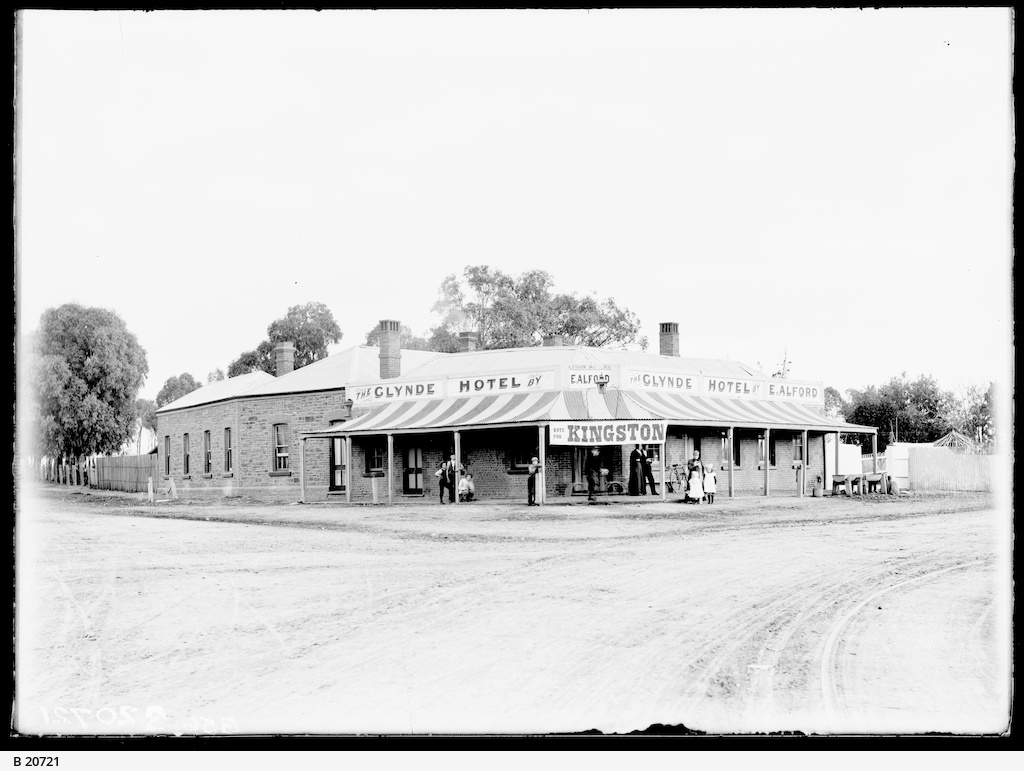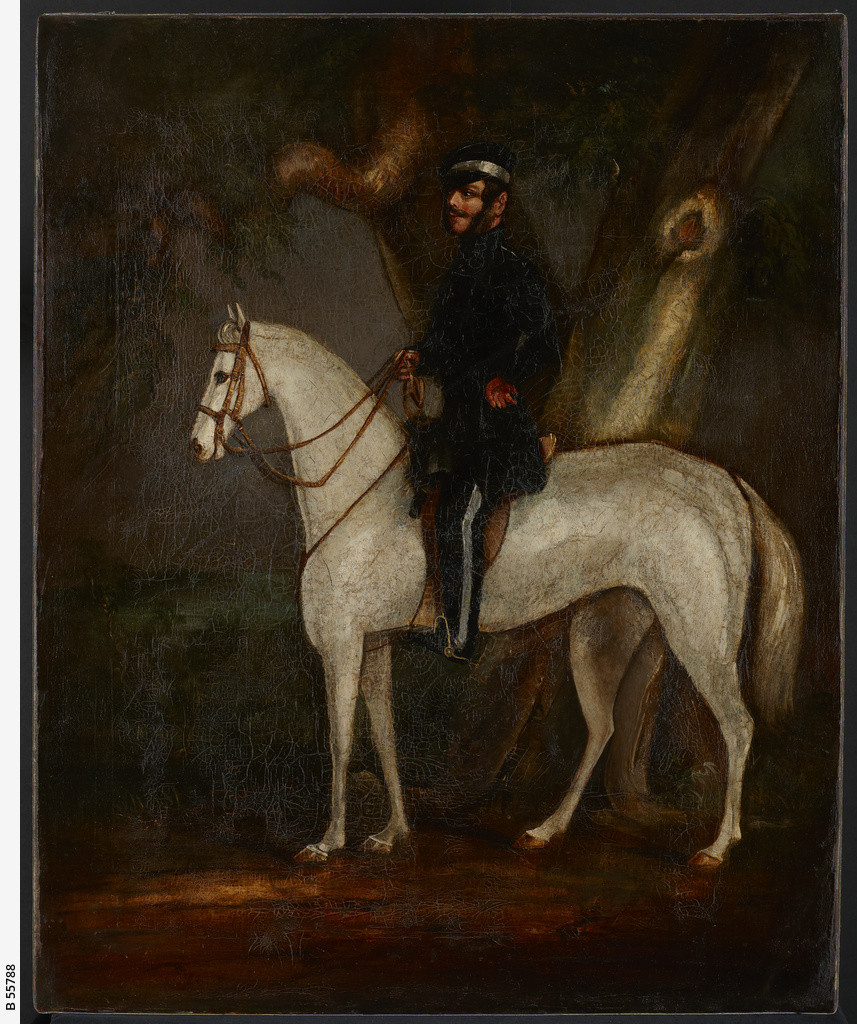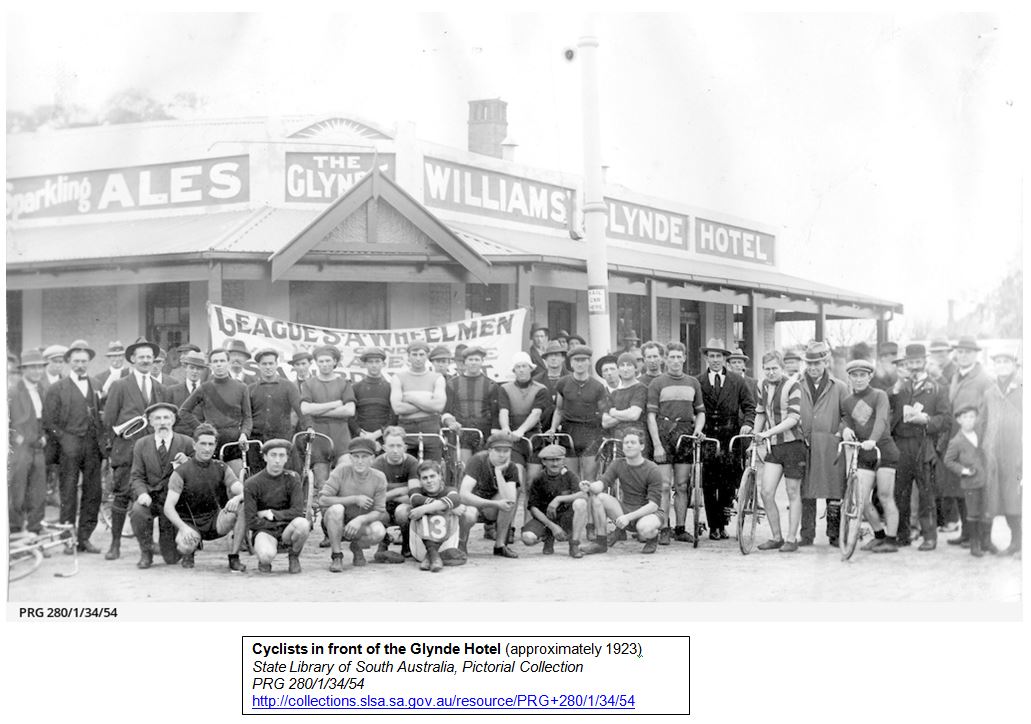Glynde Inn
The Glynde Inn was first licensed in 1855. At that time Glynde was a rural village. Just like the rural towns of today, the Inn or Pub was the focal point of the community. Anything that involved the community in numbers took place at the Inn. This was the case with the Glynde Inn. Some of the events included, the district court sitting, Coroner’s inquests, launching of new businesses, Friendly Society meetings, Local sub division land sales, sighting of plans and sales inquiries. Horse racing was often held nearby. When some locals decided to form The East Torrens Cavalry Corps, the meeting and recruitment took place at the Glynde Inn. One astute Publican decided to have a mowing contest, (open to all comers) in nearby paddocks1. Naturally the results and presentations took place at the Inn. When some near neighbours in Stepney and Mardon decided to break away from the local council and go it alone, the case for the “no” vote was fought through meetings held at the Glynde Inn.

Isaac Lloyd
The first licence in 1855 was granted to Isaac Lloyd. At the annual licensing revue, the clerk was instructed to write to the commissioner of police, about the state of the present licensed premises in the district and also to advise the granting of two new licences, for the Rock Inn at Third Creek near Magill, and also the Glynde Inn at Glynde.2 The licence was renewed in 1856 at the annual licence review, but not long after the licence was transferred to Henry Alford,3 Isaac Lloyd had been declared insolvent.

Henry Alford & the early SA Police Force
The new owner Henry Alford was a pillar of society and held in very high regard in the Colony. He came to South Australia on the John Pirie in 1836 and landed at Nepean Bay Kangaroo Island. He was employed by the South Australian Land Company with whom; he was under contract for twelve months. He sailed on the John Pirie to Tasmania and brought back two horses and two bullocks. These were the first livestock imported into the Colony4. When bushrangers began to terrorise people around Adelaide, he volunteered to assist the Governor and with some special constables set out to apprehend them. Two were arrested in Adelaide and a third escaped to Encounter Bay. One of the prisoners named Yeats was hanged for his crimes. The Governor realised law and order was a priority for the new Colony, so he asked Captain Inman to be Superintendent of police. Captain Inman then chose Henry Alford and one other special constable who was with him at the arrests in Encounter Bay. This was the beginning of the police force in South Australia.For the next sixteen years Henry Alford held various positions in that force including the position of Inspector in 1849. It was as an inspector that he was responsible for the Gold being brought to South Australia from Victoria, along with Mr. Tolmer. In 1852 he left the police force and went into business, and in 1856 the licence of the Glynde Inn was transferred into his name.
Glynde Local Court & Oddfellows
The Glynde Inn became the district court for the area. The Coroners court met there to find out who was responsible for a fire in the area in 1856.5 Sometimes, perhaps through a little too much alcohol at the Glynde Inn, a drinker would take on a bet, that his horse was faster than someone else’s. These races were all conducted properly, under Jockey Club rules, and held near the Inn. The landlord (Mr. Alford) would hold the stakes until a result had been declared. Sometimes there was a dispute over the result and in one case it was taken before the local court, Allington V Nurse.6 Mr Alford was a member of the I.O.O.F. or Oddfellows as they were called. So the Loyal Newton Lodge of Oddfellows requested that they may be allowed to move from meeting in Norwood to meeting at the Glynde Inn. There was some objection, by the Norwood Lodge but the matter was eventually passed.
Building and Investment Society
In 1856, some local identities decided to float the idea of a Building and Investment Society. An advertisement was placed in the Adelaide Observer inviting anyone who was interested in becoming a shareholder to attend. The rules would be available to be read, and if you were at all interested in becoming a shareholder, you would be able to purchase shares at the meeting. It was stressed to all and sundry, that this was not a society formed to bring great returns to shareholders, but was a means of the ordinary working man to supplement his income. Some similar societies boast 50% profits but have horrendous costs. That was not the aim of this society. Their overheads would be reduced to a minimum by a generous donation of an office, so rent was of no concern to the society. Directors fees and the Secretary’s salary would be half that of a similar society already operating. Among the trustees were very familiar names to the people of East Torrens. David Wark M.D., Price Maurice Esq., Alfred Hallett, and J.H.C. Gome to name a few.7 If you didn’t want to buy shares in The Building and Investment Society, perhaps you felt better about buying a block of land at Hectorville with first rate soil and water. The sale was held at the Glynde Inn and the plans were also able to be seen at the venue. Cash or Credit, it didn’t matter for those anxious to do a deal.8
James & Robert Nurse
By 1859 Henry Alford was looking for a quieter life, so he decided to sell the Inn and its licence. The purchaser’s were two brothers James and Robert Nurse. The Nurse brothers had no experience of licensed premises. They had no assets either, but thanks to a generous father and uncle, they were able to pay the £500 for stock and fittings. In 1859 some locals decided to form The East Torrens Cavalry Corps. The meeting was held at the Glynde Inn of course. There was a good attendance and before the night was over 16 persons had volunteered to join. The organisers were very pleased with what they had achieved, but before they could get the ball rolling their plans were dashed. Gold was discovered in the Snowy Mountain area and there was a mass exodus of potential troopers. The plans were shelved for about eighteen months when again a meeting was held at the Glynde Inn to form the East Torrens Cavalry Corps. When the organisers asked for assistance from the Government they were told they could not get assistance unless they formed a troop of Mounted Rifles. The Government would supply the rifles and £4 10s per head, for uniforms of the East Torrens Mounted Rifles. The Government had issued Enfield Rifles to volunteers in the Colonies defence force. When they had left or ceased to volunteer the rifles were never returned. So the Government put advertisements in the paper saying that if you still had an Enfield Rifle, issued to you by the Government of South Australia, and you no longer needed it to defend the Colony, it was to be returned. For those who did not return it, a fine would be imposed, as per the original agreement on which it was loaned.9 Whilst at the Glynde Inn James Nurse’s wife had twins and Robert Nurse’s wife had a son.
Henry Alford Jr.In 1860 James and Robert Nurse were declared insolvent and the licence was transferred to Henry Alford Jun.10 His father, Henry Alford Sen. regained the licence again in 1864.11 In 1867 there was unrest by ratepayers in Stepney and Mardon. They wanted to split the Payneham Council. A petition was sent to the Governor requesting this move.12 The ratepayers of Glynde were up in arms and the movement for, no split, was hatched and organised from meetings at the Glynde Inn. The reasons given, in the letter to the Governor, was that the ratepayers of Stepney and Mardon could not afford to go on paying, the high rates that would be required for the upkeep of roads to the east of them, particularly Montecute Road. They also declared that the money raised by rates was not being spent in their area but elsewhere. The ratepayers of Glynde were incensed because the roads in Mardon and Stepney were in very good condition, because they had paid for them in their rates. The amount spent on their roads was little because of the upkeep of the roads round Stepney.
As always since the first licence was granted, The Glynde Inn was the rallying point for the people of Glynde. It was to the Alford family that they owed their thanks. To Henry Alford Sen., a respected citizen, a business man, a man who believed in the area. He donated a block of land at Hectorville for a courthouse.13 His son took over the licence and steered the same course, and returned the licence back to his father.

BULLOCK ROAD RACE
The Bullock Road Race, of 16 miles, was conducted under the auspices of the League of South Australian Wheelmen last Saturday afternoon. There was a large attendance at the Glynde Hotel, Hectorville, to witness the start and finish of the contest. Frank Mariner won by about three-quarters of a mile dn 52m. 25s. A good race for second prize ended in S. Riley (4m.-50.50) beating A. v. Butson (3.30-50.21), the Goodwood junior. J. J. Mariner covered the course in 48.32, and secured the award for fastest unplaced prize. Our photograph shows a group of competitors at the Glynde Hotel.
1922 'BULLOCK ROAD RACE.', Observer (Adelaide, SA : 1905 - 1931), 29 July, p. 24, viewed 13 October, 2015, http://nla.gov.au/nla.news-article165658475
This article has been researched and compiled by Jim Nelson, Volunteer with the Campbelltown Library Digital Diggers group
If you have any comments or questions regarding the information in this local history article, please contact the Local History officer on 8366 9357 or hthiselton@campbelltown.sa.gov.au
References
- 1865 'GLYNDE MOWING MATCH.', South Australian Weekly Chronicle (Adelaide, SA : 1858 - 1867), 11 November, p. 3, viewed 13 October, 2015, http://nla.gov.au/nla.news-article94734308
- 1855 'EAST TORRENS', South Australian Register (Adelaide, SA : 1839 - 1900), 3 March, p. 2. , viewed 08 Jan 2020, http://nla.gov.au/nla.news-article49307921
- 1856, South Australian Register (Adelaide, SA : 1839 - 1900), 20 June, p. 4. , viewed 08 Jan 2020, http://nla.gov.au/nla.news-page4143470
- DEATH OF MR. HENRY ALFORD. (1892, February 27). South Australian Chronicle (Adelaide, SA : 1889 - 1895), p. 8. Retrieved October 13, 2015, from http://nla.gov.au/nla.news-article91547985
- 1856 'CORONERS' INQUESTS ON FIRES.', South Australian Register (Adelaide, SA : 1839 - 1900), 25 January, p. 4. , viewed 08 Jan 2020, http://nla.gov.au/nla.news-article49747708
- 1861 'LOCAL COURT—ADELAIDE.', South Australian Weekly Chronicle (Adelaide, SA : 1858 - 1867), 22 June, p. 7. , viewed 08 Jan 2020, http://nla.gov.au/nla.news-article90036973
- 1856 'Advertising', Adelaide Observer (SA : 1843 - 1904), 26 January, p. 1. , viewed 08 Jan 2020, http://nla.gov.au/nla.news-article161256627
- 1857, South Australian Register (Adelaide, SA : 1839 - 1900), 16 February, p. 4. , viewed 08 Jan 2020, http://nla.gov.au/nla.news-page4146533
- 1861, Adelaide Observer (SA : 1843 - 1904), 12 October, p. 3. , viewed 08 Jan 2020, http://nla.gov.au/nla.news-page18803188
- 1860, South Australian Weekly Chronicle (Adelaide, SA : 1858 - 1867), 16 June, , viewed 08 Jan 2020, http://nla.gov.au/nla.news-article90252791
- 1864, South Australian Register (Adelaide, SA : 1839 - 1900), 15 March, p. 3. , viewed 08 Jan 2020, http://nla.gov.au/nla.news-page3915136
- 1867 'PROPOSED DIVISION OF THE PAYNEHAM DISTRICT.', South Australian Weekly Chronicle (Adelaide, SA : 1858 - 1867), 13 April, p. 7. , viewed 08 Jan 2020, http://nla.gov.au/nla.news-article91258953
- 1859, The South Australian Advertiser (Adelaide, SA : 1858 - 1889), 21 January, p. 3. , viewed 08 Jan 2020, http://nla.gov.au/nla.news-page4392
